Last month’s prediction of further deterioration in the condo market has been spot on so far, and my unique instability indicators predict more trouble to come. Meanwhile, purveyors of E-Z credit are finally backing away from the ledge. I can’t believe I’m actually saying this, but: do I hear hissing?
Prices
So far, it looks like last month’s forecast for deterioration in the condo market has been spot on. Month-over-month condo prices fell again, this time joined by SFR prices as well. While year-over-year price comparisons are still positive, we are coming up against a tough year-over-year comparison next month, and the median condo price change will likely go negative at that time.
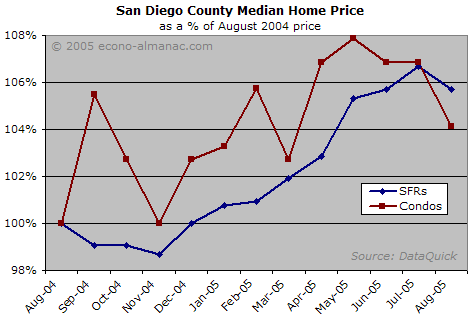
What’s more worrying to me is that my Breadth Index indicates increasing downward price pressure throughout San Diego. This index measures the percentage of zip codes that have seen positive year-over-year price changes. And while the countywide median condo price is still up 4% year-over-year, the following graph demonstrates that a full 27% of San Diego zip codes actually saw their median condo price decline on the year:
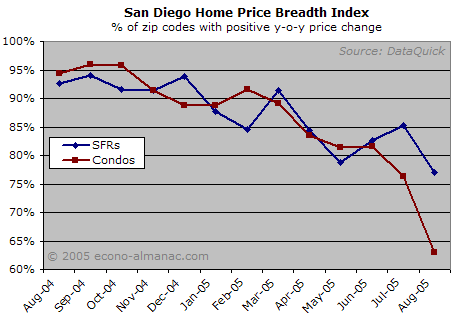
Meanwhile, the amount of San Diego zip codes that have experienced condo price declines of 5% or more shot up since last month:

This indicates that while the county as a whole isn’t doing too poorly, condo markets in certain areas are coming under heavy pressure. This could be a portent of a more widespread condo market downturn to come.
As the above charts indicate, the SFR market is doing quite a bit better than that of condos. SFR prices were down month-to-month, but they aren’t far from their recent record high. Meanwhile, regional price breadth is still decent: 77% of zip codes are still showing positive year-over-year SFR price gains, and only 11% of zip codes have seen SFR prices decline by 5% or more. So SFRs are hanging in ther for the time being, but that won’t be the case for long if condos continue downward.
Sales Volume
Sales volume was surprisingly strong, given the lackluster pricing power. Of course, most of the volume increase was confined to the SFR market:
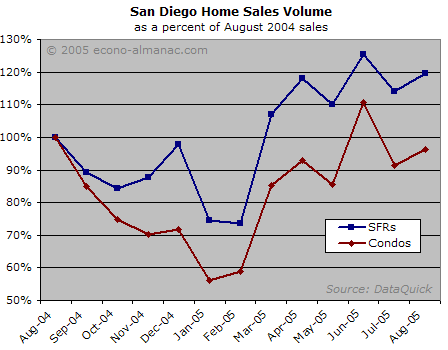
SFR sales were actually up 20% compared to August 2004, and condos were almost able to match last August’s figure. This August marked the first time in a year that either the SFR or condo market showed a positive year-over-year change in sales volume:
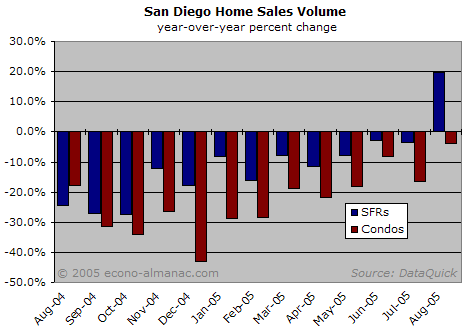
Increasing home sales volume is typically a bullish sign, as it indicates an increase in demand. However, given the rather anemic pricing power discussed above, it is hard to believe that we are seeing the start of a trend towards higher demand. You will also note that sales didn’t actually increase a whole lot since the prior month. It seems that this apparent leap in demand is actually just statistical noise due to an unusually low volume of SFR sales in August of 2004. If future data indicates otherwise, I will of course re-evaluate this theory, but for now the most plausible explanation is that the jump in year-over-year SFR sales is not meaningful.
Inventory
The inventory increase marches onwards, with inventory having grown over 60% in the past 6 months:
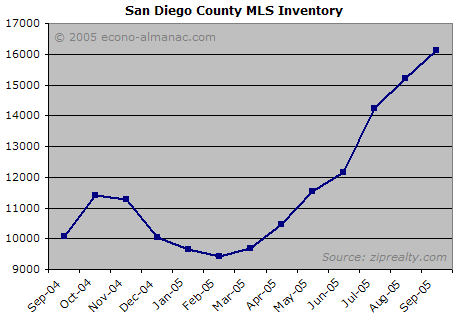
Here’s the very clear upward trend in inventory superimposed over the very clear sideways-to-down trend in sales.

The condo glut is as dramatic as ever over in Craneville, USA—otherwise known as Downtown San Diego, where inventory is up over 200% on the year.
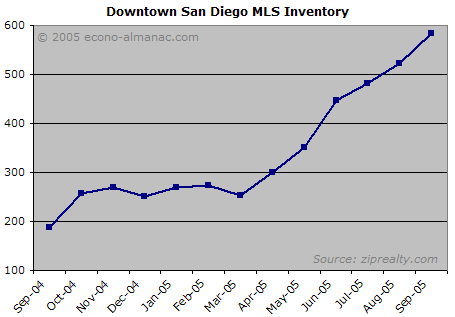
I am floored that so many people continue to claim, with a perfectly straight face, that there is a housing shortage in San Diego. I’m sure we could quibble over what precisely comprises a housing shortage, but I’m pretty sure something that doesn’t comprise a housing shortage is a tripling of inventory against flat sales.
Conclusion
After all these years, I believe that the bubble may finally be starting to burst.
Condo prices have headed downwards for three months, and at this point 25% of San Diego zip codes are sporting a year-over-year median condo price decline of at least 5%. SFR prices are much more stable for the time being, but the cracks are starting to appear. It is against this backdrop of weak pricing power that inventory marches unrelentingly upward.
This information, if fairly worrisome, is not by itself enough to embolden me to finally call the top of San Diego’s housing market. However, the weakness in the supply/demand situation appears much more ominous in light of recent developments in the credit market.
As you’ll recall from the monthly credit market report, mortgage lenders are finally starting to feel the squeeze of Fed tightening, and a surge in inflation expectations all but guarantees further rate hikes to come. It appears that the sea of E-Z credit may finally be starting to dry up. If this trend continues—if adjustable mortgage rates continue to rise, and lenders further tighten their standards—it will be very, very bad for the San Diego market. And given that San Diego housing is already deteriorating noticably, things will just go from bad to worse.
There is always the possibility that inflation expectations will recede so that the Fed can loosen credit, or that an enormous influx of foreign capital will allow lenders to start lowering their standards again. But at this point the odds favor neither scenario. If recent trends in the credit market continue, as they appear likely to do, then the San Diego housing market’s great decline has probably already begun.
